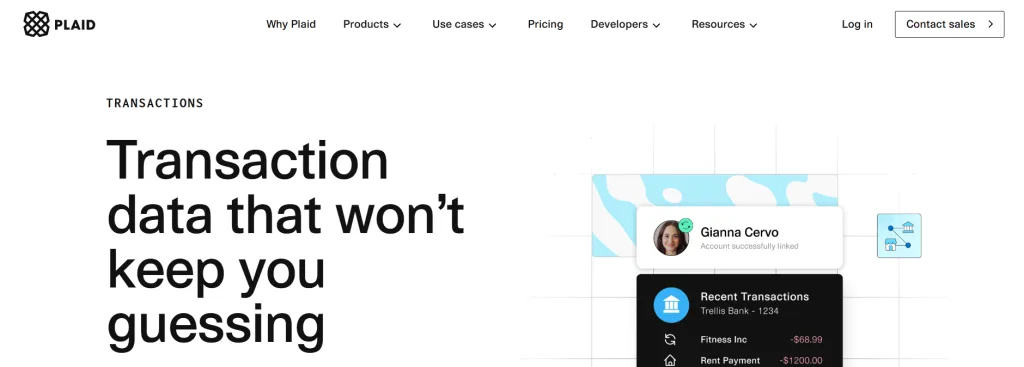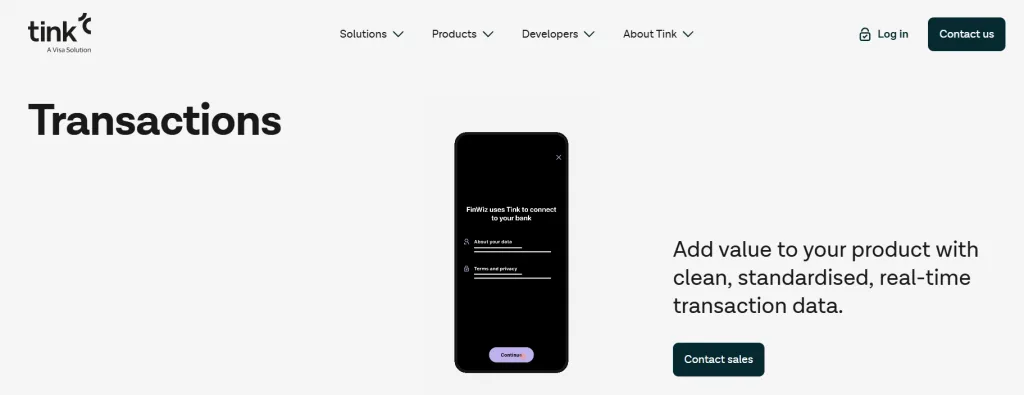Messy transaction data isn’t just a developer headache; it’s a product killer.
For UK fintechs building personal finance tools, SME credit platforms, or real-time risk models, raw bank feeds often arrive cluttered with vague merchant references, inconsistent labels, and duplicated entries. That noise leads to poor categorisation, failed automations, and lost trust with users.
This is where the Plaid vs Tink conversation gains traction.
Both are widely adopted Open Banking providers in the UK and Europe, offering access to transaction data across thousands of accounts. But they differ in how that data is cleaned, categorised, and structured for live fintech use.
In this guide, we’ll compare them across:
✅ Bank coverage and refresh frequency
✅ Categorisation depth and accuracy
✅ Merchant name enrichment and logo support
✅ Real-time latency
✅ Product fit for different fintech verticals
If your team is deciding between Plaid and Tink for building data-driven features that rely on clean, enriched transactions, this is the comparison that matters.
TL;DR: Plaid vs Tink for Clean Transaction Data?
| Platform | Best For | Categorisation Depth | Merchant Enrichment | UK Bank Coverage | Data Refresh Speed |
|---|---|---|---|---|---|
| Plaid | Fintechs needing broad categorisation across many transaction types | High – over 90% category tagging accuracy | Basic merchant names + location metadata | 95%+ of major UK institutions | On-demand & scheduled refresh available |
| Tink | Products requiring rich merchant detail and behavioural insights | Strong – enhanced with spend type & CO₂ tagging | Merchant logos, brand names, recurring spend detection | Full FCA-licensed UK access + 18 EEA markets | Real-time enrichment + predictive spend tagging |
Why Clean Transaction Data Matters for UK Fintechs
Clean transaction data isn’t just about UX polish, it’s foundational for every fintech product that relies on real-time insights, automated workflows, or regulatory reporting.
From personal budgeting tools to SME credit checks, when transaction feeds arrive with missing categories or vague merchant labels, it breaks trust and creates operational drag.
Platforms using enriched, categorised bank data see stronger product outcomes:
- Faster onboarding – instant visibility into recurring income and risk indicators
- Sharper credit models – reliable categorisation helps flag high-risk spending
- Lower fraud exposure – merchant enrichment filters out anomalies early
- Less developer time spent fixing feeds – fewer internal rules, less patching
- Better customer experience – users can actually read and recognise their own spending
Whether you’re building a BNPL engine, a real-time risk score, or just need users to recognise their own transactions, accurate data enrichment is what makes the difference between confusion and clarity.
This is where providers like Plaid and Tink diverge not in how much data they access, but in how well they clean it up.
📚 Guide to Raw vs Clean Transaction Data
Plaid Data Insights

UK Bank Coverage & Licensing
Plaid operates as an FCA-registered Account Information Service Provider (AISP) with coverage across over 95% of UK consumer and business banks. This includes major institutions like Barclays, Lloyds, HSBC, Monzo, Starling, and more. Their institutions/get endpoint confirms wide coverage with frequent refresh support across current and savings accounts.
Plaid is also PSD2-compliant and passported into the EU, but in this guide, we focus on UK-specific bank data access.
Enrichment Stack & Categorisation Logic
Plaid’s enrichment engine applies category labels, transaction types, location metadata, and merchant name parsing to raw Open Banking feeds. Their enrichment accuracy exceeds 90% in UK datasets, according to internal benchmarks. This allows fintechs to classify spending into clear categories like “Groceries,” “Transport,” or “Utilities”, essential for PFM and credit-scoring tools.
While merchant logos are not natively included, Plaid provides merchant-cleaned names, domain-level website links, and in some cases, geotags for enhanced display.
Developer Tooling & Integration
Plaid is widely praised for its developer experience. The platform supports OAuth-compliant redirects, granular data scopes, sandbox testing, and real-time webhooks. For fintech teams building with Python, Node.js, or React, Plaid’s developer guides and SDKs are detailed and continuously updated.
Pros
- High categorisation accuracy out of the box
- Strong UK bank coverage across major institutions
- Reliable refresh support for live and historical data
Cons
- Limited merchant branding (no logo support)
- Requires client-side token flow setup
Best-Fit Use Cases
Plaid works well for UK fintechs that need broad categorisation coverage with fast integration, especially in:
- Budgeting apps (e.g., spend tracking)
- BNPL affordability checks
- Cash flow models for freelancers or SMEs
Tink Enrichment Suite

Merchant-Level Enrichment & Behavioural Insights
Tink offers a robust transaction enrichment layer that goes beyond simple categorisation. It includes:
- Merchant logos and brand names
- Recurring transaction detection
- Spend-type classification (e.g. fixed vs variable)
- Detailed subcategories for granular financial analysis
These features make Tink well-suited for UK fintechs building smart dashboards, expense breakdowns, or affordability checks where clarity and user recognition are key.
Their categorisation engine applies structured labels across hundreds of categories, including subscriptions, housing, financial services, and discretionary spending.
Coverage & Regulatory Status
Tink is authorised as an AISP by the FCA and licensed across the EU under PSD2. It connects to all major UK banks, along with financial institutions in 18+ EEA countries, making it a strategic fit for multi-market fintechs with UK operations.
Direct bank connections and regular syncs contribute to high data reliability and refresh speeds, supporting both live and historical analysis.
Predictive Spend Detection
A standout feature is Tink’s ability to identify recurring payments like rent, subscriptions, or salary deposits even when exact amounts vary slightly. This helps fintechs surface income patterns, flag missed payments, and support automated budgeting.
Tink includes predictive tagging with confidence scores, which can be integrated into risk models, financial planning tools, or customer alerts.
Integration & Developer Experience
Tink provides a single enrichment API and follows standard OAuth-based flows. Their SDKs for iOS, Android, and web offer tested user journeys and are designed for production use with built-in authentication and error handling.
Pros
- Merchant logos and branding enrich the user interface
- Predictive spend detection helps surface recurring transactions
- Full UK coverage plus multi-country support for scaling teams
Cons
- SDKs are less flexible than Plaid’s for highly custom front ends
- Merchant logo support may be less reliable for niche merchants
- Enrichment configuration options are more limited out-of-the-box
Where It Fits Best
Tink is best suited for fintech products that require well-presented transaction data and behavioural insights, particularly in:
- Digital banks or e-money wallets
- Credit builders and affordability tools
- Multi-country fintechs operating in the UK and EU
Comparing Plaid and Tink
Choosing between Plaid and Tink often comes down to subtle but critical differences in how they handle enrichment logic, coverage, and integration complexity. The table below compares both platforms across the six most important factors for UK fintech teams building on top of transaction data.
| Decision Factor | Plaid | Tink |
|---|---|---|
| Coverage | Covers 95%+ of UK banks including all major high street and challenger banks | FCA-licensed in the UK with coverage across all major institutions + 18 EEA markets |
| Categorisation Accuracy | High accuracy (>90%) for common spending categories in UK datasets | High accuracy with added spend-type logic (e.g., fixed vs variable) |
| Merchant Enrichment | Basic merchant name, location, and domain metadata | Branded merchant names, logos, and merchant-type segmentation |
| Recurring Payment Detection | Limited; based on transaction metadata alone | Built-in recurring detection engine with confidence scores |
| Latency / Refresh Speed | Supports scheduled and on-demand refresh via token | Real-time enrichment flow with predictive spend tagging |
| Integration Lift | Lightweight SDKs with wide language support and sandbox testing | Pre-configured SDKs for mobile/web with tested UX flows |
This comparison is based on publicly documented features, developer portals, and verified enrichment capabilities as of 2025.
Finexer: The Affordable Bank Data Alternative Built for UK Fintechs

Most enrichment providers force UK teams to choose between wide bank coverage and merchant-level clarity, often at the cost of slow onboarding or rigid pricing.
Finexer gives you both.
With direct access to 99% of UK bank accounts, Finexer delivers clean, categorised transaction data that’s ready for credit decisioning, onboarding, and real-time spend analysis without long integration cycles or inflated enterprise contracts.
Why UK Fintechs Choose Finexer:
- ✅ Merchant-level enrichment: Get clean merchant names, categories, and spend types from live account feeds
- ✅ Built for UK coverage: Full support for major and challenger banks, business and personal accounts
- ✅ Live in days, not months: Fast integration with developer-first documentation and support
- ✅ Usage-based pricing: Ideal for fintechs scaling unpredictably or launching new features
- ✅ FCA-authorised: Compliance-ready for regulated workflows in the UK
Finexer gives you direct access to merchant-cleaned transaction data from UK banks so your team can focus on building smarter features, not fixing messy feeds.
“Our business isn’t about the volume of consents—it’s about delivering high-quality services to some of the biggest names in the industry. We needed a partner who understood the importance of providing business-focused solutions, and Finexer joined us on that journey.”
Penny Phillips, Chief Commercial Officer at Sysynkt.
Get Started
Connect today and see why businesses trust Finexer for secure, compliant, and tailored open banking solutions.
Try NowWhich provider refreshes transaction data faster?
Plaid supports both scheduled and on-demand refreshes via access tokens. Tink offers real-time enrichment with predictive tagging on recurring spend, which is useful for time-sensitive insights.
Can Tink detect subscriptions or regular payments?
Yes. Tink includes a recurring transaction engine that identifies patterns like rent, subscriptions, or salary, even if amounts fluctuate. This supports use cases like affordability scoring and missed payment alerts.
Is there a faster, more affordable UK-focused alternative?
Yes. Finexer offers merchant-cleaned transaction data from 99% of UK banks, with developer-friendly APIs and usage-based pricing. It’s ideal for fintech teams that want to go live quickly without managing complex enrichment pipelines.
Stop Fixing Bank Feeds. Start Building with Finexer! Get Clean Transaction data at an affordable cost & launch faster 🙂
